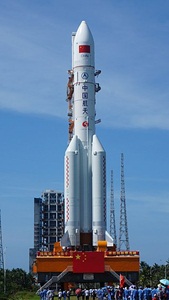China's Long March-5 made a successful flight on Friday when the country’s largest carrier rocket soared into the sky like from the Wenchang Space Launch Centre on southern China's tropical island province of Hainan.

The success of the Long March-5, which has a carrying capacity of 8 tonnes, is considered as another milestone in a series of future space projects for China, including exploring Mars, returning moon samples and constructing its own space station, Xinhua stated in a report.
The Long March-5 Y3 rocket successfully placed the 8-tonne Shijian-20 technological experiment satellite, China's heaviest and most advanced communications satellite, into its planned orbit.
The Long March-5, a huge, two-stage rocket, is capable of carrying a payload of up to 25 tonnes into low Earth orbit, 14 tonnes to geostationary transfer orbit and 8 tonnes to Earth-Moon transfer orbit, which is more than twice the capacity of the current main Long March rockets.
The carrier rocket Long March-5 Y3 blasted off from the Wenchang Space Launch Centre in south China's Hainan Province, at 8:45 pm (Beijing time), leaving a trail of huge flame and lighting up the clouds and sea, according to the report.
The success of the Long March-5, after suffering a failure two years ago, ensures that the carrying capacity of China's launch vehicles is among the highest in the world.
Wu Yanhua, deputy director of the China National Space Administration, said the success of the flight lays the foundation for a series of future space projects for China, including exploring Mars, returning moon samples and constructing its own space station.
The Long March-5 made its maiden flight on 3 November 2016, from Wenchang. However, the second large rocket, Long March-5 Y2, suffered a failure, as a malfunction occurred less than six minutes after its liftoff on 2 July 2017.
The failure of the second rocket was reportedly caused by a problem in the engine of the first core stage of the rocket. "We have made improvements to the design, materials and technologies of the engine," said Li Dong, chief designer of the Long March-5 rocket.
"Under great pressure, the research team has put all the wisdom and efforts into the rocket over the past two years. We are very proud that we can participate in the development of the Long March-5, which represents the highest level of China's rocket technology," Qu Yiguang, deputy general director of the Long March-5 Y3 research team, said.
The rocket uses relatively more environment-friendly fuel, including kerosene, liquid hydrogen and liquid oxygen, rather than highly toxic propellants.
The Long March-5 rocket, with completely independent intellectual property rights, uses more than 200 key technologies, according to Xinhua.
Advanced digital technologies were applied in the design, analysis and tests of the Long March-5 rocket, which greatly shortened the development cycle and decreased costs.
More than 10,000 space engineers participated in the design, research and development of the Long March-5, which lasted for more than 10 years, the report added.





















